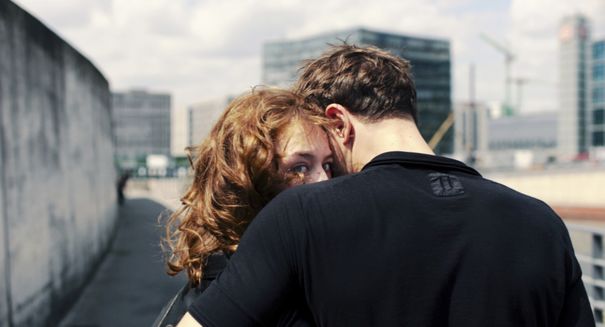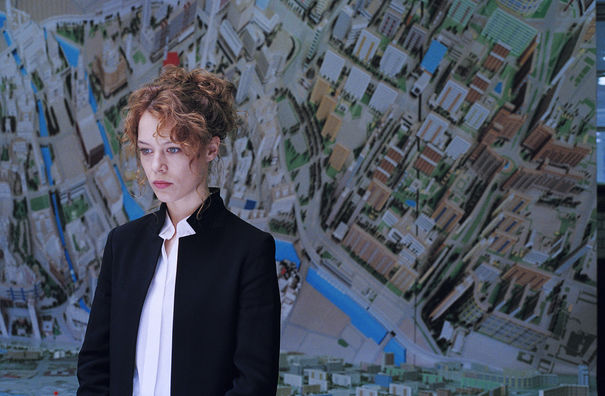Letters from Berlin: Undine Loves
Reporting from Berlin, Savina Petkova and Debbie Zhou share their thoughts on Christian Petzold’s Competition entry, Undine
by Savina Petkova & Debbie Zhou

© Christian Schulz/Schramm Film
Savina:
Is there a way to render a fairytale romantic when it isn’t fated to be one? Christian Petzold lends his characters possibilities to break away from the conventional time and space bonds, but ultimately, it is love that disrupts myths and patterns. In UNDINE (Germany, France), he subverts the romantic ideal of the alluring female sea spirit and her chosen one by using tragic tropes to emphasize reciprocal love. Lots of love and water bursting from the screen, yes?
Debbie:
So much. Watching the film here at the Berlinale -- where it is playing as part of the Official Competition -- is the first time I’ve been able to see a Petzold film on the big screen, and it magnified so many details of his filmmaking style that I’ve appreciated in his previous works, TRANSIT (Germany, France) and PHOENIX (Germany, Poland). Undine (Paula Beer) and Christoph (Franz Rogowski) hug and touch constantly during the movie, and the camera often holds still as Undine splays her hands over his leather jacket, her head in the nook of his neck, his arms around her.
Savina:
The image that’s imprinted on my mind is of Undine and Christoph's chance/fate meeting after an aquarium bursts in front of them in a splash of glass and water, to then observe the couple drown into each other even more as the film unfolds.
Debbie:
If anything -- that aquarium scene embodies the beauty of how Petzold shoots faces and the way his camera becomes a mediator in creating such intimacy and interaction between bodies. He’s able to create mood, not only through visual language, but also through the direction of his actors, and the use of sound -- particularly the silences. When the glass cracks and the couple fall on the ground next to each other -- the water was spilling down their faces, their hair and clothes soaked, glass protruding into skin -- they’re not distracted by any of it, and they only gaze at one another. It’s wordless, but in that one moment, the looks in their eyes says everything about their relationship, and where it’s headed.
Savina:
You mean the inevitability of the myth?
Debbie:
I think the mythological aspect also adds a sense of magic realism and foreshadowing to their romance, too. Before the aquarium bursts, you already hear it bubbling away under the surface: there’s the muted underwater sounds as Christoph enters the doorway, and the diver figurine in the tank begins to shake because of some unknowable force. It’s a fated ‘meet-cute’ in a way, and the film plays with that idea of inevitability within a romance.

Savina:
I’d even give it a capital ‘R’, as it’s very much in the spirit of German Romanticism, which is, after all, a way of bringing back magic into a world that’s lost its own. The narrative can be summarized as a couple meeting to only miss each other, so the tragic potential is also there – divided by death, but united by love. However, the couple’s occupations, as an industrial diver and an urban historicist in present day Berlin, makes up the harsher, material layer of this story but what opens it up for enchantment is hidden in, as you said, the framing of their first encounter. As in other Petzold films, such as TRANSIT, time, space, and memory are fluid, only in this case, they are more water than anything else.
Debbie:
And there’s so much ambiguity happening in this movie -- so much that it has seemed to divide the critics in terms of, ‘what exactly is UNDINE doing?’ and ‘what does it actually mean?’ I think part of this film’s beauty is the way that it doesn’t spell out something as explicitly, as say, a film like Transit -- which was more politically overt about the blur between past and present ways of seeing the refugee crisis, and what it means for those who are stateless or in ‘transit’. There’s a lot to try and unlock in this puzzle of a movie, and its symbols are perhaps more difficult to access too; for example -- what interpretation was Petzold putting on the mythological figure of Undine? Undine was traditionally a sexualized female water creature, without a human soul, whose purpose is to allure a human man -- but the risk, for the man, is that if he leaves her -- she’ll kill him. It’s something that Undine says very early on in the film when her to-be ex-boyfriend breaks up with her -- which was, by the way, such a cutthroat way of opening the film and bringing the audience right into her emotional headspace.
Savina:
In a way, UNDINE is also about belonging, yet condensed to a couple, especially when the screen seems too small to behold their loving looks, keeping them in the same frame as long as possible, often obscuring each other’s faces. Actually, in our interview, Petzold spoke of his reversal of the siren myth that’s based on male projection: a man concedes to a love he cannot return only because of a woman’s alluring beauty. Here, the love between the main couple feels so strong and singular because the film aligns (as the title suggests) with the heroine’s initiative, rather than keeping her merely a fetishized object. That’s also the premise of the novel “Undine Leaves” by Austrian writer Ingeborg Bachmann. What I’d add here is that his reworking of the myth has more to do with the notion that repetitions – scenes replayed as flashbacks, Undine practicing her history talk three times, or how the film obsessively returns to its locations again and again– shape our lives and loves, and breaking from patterns might be the only way to be with someone and belong.
Debbie:
Is there something about that reworking of the myth that aligns with his emphasis on modern Berlin architecture too? I think that was something in particular that I’ve been grappling with a lot now, even if I was very struck by it during the movie. Because is there a connection between Undine’s work as a historian, the details of how the city has become shaped and designed in such intricate detail post-WWII -- to the core romance, its development and the ending? Is there a reason that the fate of these two lovers ends up being what it is? Petzold’s films work so interestingly in this space between Germany’s past, present and future, and I think that this time, his additional layer of a re-interpretation on a myth, actually complicates and perhaps confuses this question or query.
Savina:
I took a moment to appreciate the fact that we, being in Berlin, were watching a film that takes its time to explain the city’s urban planning and its name meaning ‘dry place in the marsh’, in long, repeated talks that might seem at first alienating and function as a stoppage to the narrative unfolding, but for us, then and there, encapsulated the singular experience of its first screening. In a way, this is also does away with patterns, of viewing in that case, underneath its jargon, Undine’s talk reminded me of Freud’s comparison of the psyche as a city where past, present, and potentiality coexist like the city’s own history and ruins. Freud had Rome in mind, but I think Petzold uses Berlin in a similar way without taking cameras to the streets but paying close attention to historically accurate models. Last but not least, the Berlinale Palast where our screening took place, also overlooks a lake.

